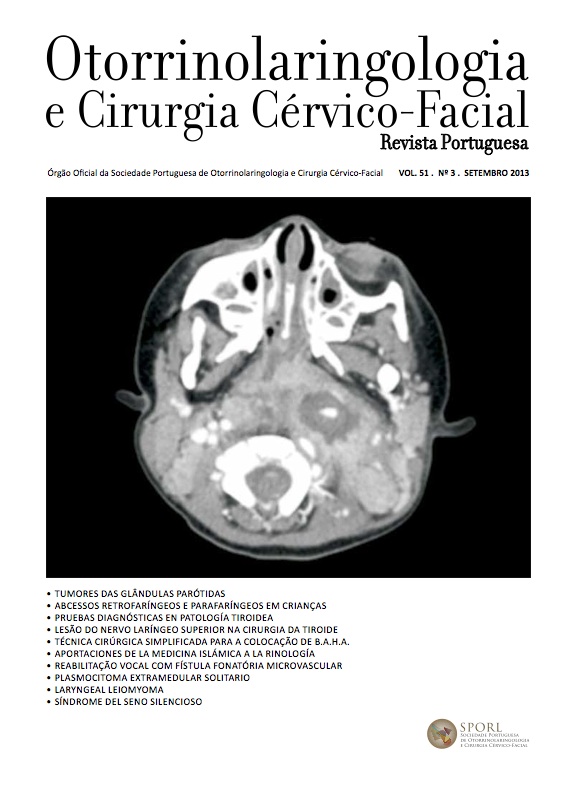Parotid tumors - Casuistry of the last 10 years of the Otolaryngology Department of Lisbon IPO
DOI:
https://doi.org/10.34631/sporl.61Keywords:
Salivary glands, Parotid gland, Benign tumors, Malign tumors, SurgeryAbstract
The salivary gland tumors are uncommon neoplasms of the head and neck region, corresponding to 3-5% of the tumors in this location.
In this article we will be doing a retrospective study of the occurrence of tumors of the parotid gland over the past 10 years in the Department of Otorhinolaryngology IPO Lisbon. Data were collected from a total of 153 patients from the period of 1st January of 2001 to 31st December of 2011 and was evaluated the incidence of the various subtypes of tumors, treatment given and the follow-up of patients. We also took into account the possible complications, recurrences and complementary treatments.
We have concluded that, as in the bibliography, these tumors are rare and mostly benign, having a proportional ratio between the size of the salivary gland and benign tumor.
The treatment of choice for the parotid gland neoplasm is surgery, regardless of whether it is a benign or malignant tumor, since there is a steady growth of tumor and its malignant potential.
Downloads
References
Spiro, J; Spiro, R. Cancer of the Parotid Gland: Role of 7th Nerve Preservation. World Journal Surgery. 2003;27:863-867.
Johnson, J T; Ferlito, A; Fagant, J J; Bradley, P J et al. Role of limited parotidectmomy in management of pleomorphic adenoma. The Journal of Laryngology and Otology 2007, 121:1126–1128.
Roh, Jl; Park, C. Function-Preserving Parotid Surgery for Benign tumors Involving the Deep Parotid Lobe. Journal of Surgical Oncology. 2008, 98:42-45.
O’Regan, B; Bharadwaj, G. Tumor Recurrence after Surgical Removal of Parotid Pleomorfic Salivary Adenoma using Retrograde facial nerve dissection technique. The British Journal Oral Maxillofacial Surgery. 2011: Aug 29.
Guntinas-Lichius; B, Gabriel; Klussmann, JP. Risk of facial palsy and severe Frey’s syndrome after conservative parotidectomy for benign disease: analysis of 610 operations. Acta otolaryngolo. 2006. Oct126(10):1104-9.
Al-Naqeeb, NI; dashti, H; al-Muhanna, AH; Behbehani, A. Parotid gland tumours: a 15-year experience. Journal of the Royal College of Surgeons of Edinburgh. 1992 Apr;37(2):89-93.
Diaz, P; Castillo, R; Plata, M; Gías, L et al. Clinical results in the management of Frey’s Syndrome with injections of Botulinum Toxin. Medicina Oral Patol Oral Cir Bucal. 2008: Apr 1; 13(4):E248-252.
Sharma, R; Sirohi. Proximal and distal facial nerve exploration during superficial parotidectomy. Journal Maxillofacial Oral Surgery. June 2010: 9 (2):150-154.
Rustemeyer, J; Eufinger, H; Bremerich, A. The inicidence of Frey’s Syndrome. Journal of Cranio-Maxillofacial Surgery. 2008:36, 34 e 37.
Upton, D; Mcnamar, J; Connor, N; Harari, P et al. Parotidectomy: ten- year review of 237 cases at a single institution. Otolaryngology-Head and Neck Surgery. 2007: 136, 788-792.
Gehanno, P; Guerrier, B; Pessey, J; Zanaret, M. Les tumeurs de la parotide. Les Monographies du CCA Group. 2003: n35.
Meyers, E; Ferris, R. Salivary Glands Disorders. Springer 2007.






